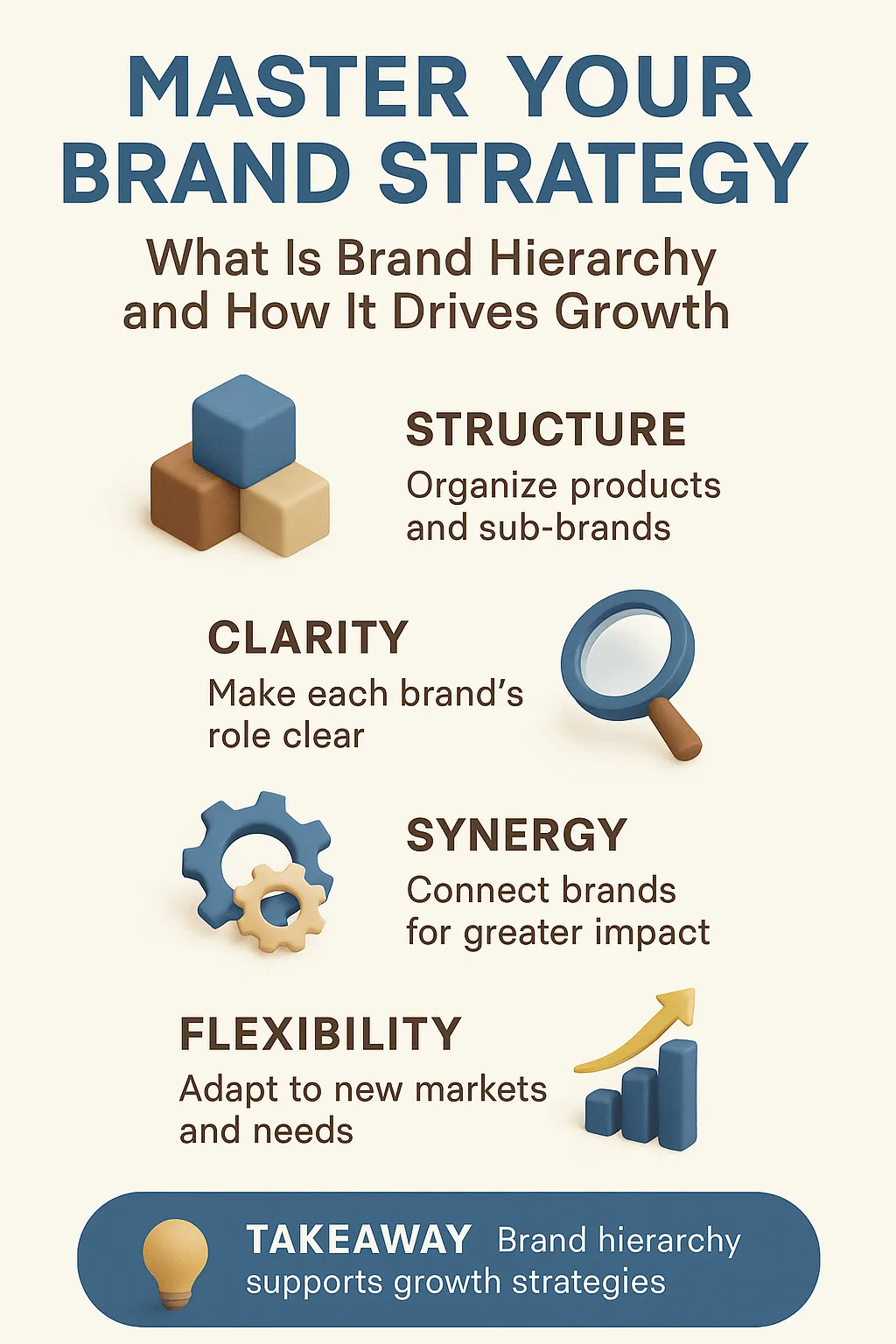Brand confusion isn’t always obvious—until it starts costing you growth. After working with dozens of brands across industries, we’ve learned that one of the most underutilized yet powerful tools in brand strategy is brand hierarchy. Recognizing what is brand hierarchy allows businesses to structure their brand architecture effectively, simplifying their branding system while laying the groundwork for consistency, scalability, and customer trust.
Whether you're managing multiple products, scaling through acquisition, or simply trying to build a clearer customer experience, understanding and using brand hierarchy the right way can give you a competitive edge.
Top Takeaways
- Brand hierarchy creates clarity and builds trust.
- It aligns teams and reduces marketing inefficiencies.
- Structured brands see higher recognition and lower costs.
- Leading brands implement hierarchy early.
Small businesses also benefit from clear brand structure.
Why Brand Hierarchy Fuels Strategic Growth
Brand hierarchy is the framework that defines how a company organizes its brands, sub-brands, services, and products. Instead of letting each brand float independently, hierarchy brings order.
It creates clarity in your messaging, strengthens recognition, and helps customers understand the relationship between your offerings—especially when launching something new. We’ve seen firsthand how even a small shift in brand architecture can improve internal collaboration and elevate public perception.
When each brand has a purpose and position within the hierarchy, companies scale smarter, communicate stronger, and build deeper loyalty. This clarity becomes especially powerful when partnered with multicultural digital marketing agencies that understand how to tailor messaging across diverse audiences while maintaining a unified brand identity.

Real Results: Brand Structure That Drives Success
Challenge: A growing home services company has acquired several regional brands. Each had its own name and look—confusing customers and straining marketing budgets.
Symptoms:
- Disconnected names and logos
- Poor brand recall
- Siloed internal operations
- Master Brand Alignment: Elevated the parent brand across all materials
- Endorsed Brand Integration: Added “Powered by [Master Brand]” to regional brands
- Service Naming Standardization: Unified service categories for simplicity
Results:
- 43% increase in master brand recognition in 6 months
- 21% drop in marketing costs
- Higher trust ratings in customer surveys
Lesson: Structure isn’t just about logos. It’s about aligning business strategy with customer expectations—something a woman-owned marketing agency often approaches with uniquely inclusive, empathetic insight rooted in real-world connection.
Data That Backs It Up
Brand hierarchy isn’t just good practice—it’s backed by real research:
- 81% of U.S. consumers say they must trust a brand before buyingSource: Edelman Trust Barometer
- Consistent branding can increase revenue by up to 20%Source: Lucidpress Branding Report
- Marketing strategy roles are growing 8% through 2033Source: U.S. Bureau of Labor Statistics
These findings align with what we observe across clients: structure builds trust, and trust drives revenue—core principles that every experienced advertising agency knows are critical for long-term brand success.
Key Insights You Should Remember
- Brand hierarchy gives your brand clarity, not complexity
- It unites your messaging and guides internal decision-making
- Successful brands structure early—they don’t wait for chaos to build
- Customers engage more with brands that “make sense” from the outside in
What to Do Next
Here’s how to begin implementing or refining your brand hierarchy:
- Audit your brand family: Identify all brands, sub-brands, and offerings
- Define relationships: Group them as master, sub-brand, or endorsed
- Align design and messaging: Apply consistent visuals and tone across touchpoints
- Map it out: Create a visual brand architecture and keep it updated
- Consult an expert: A strategic outside view can reveal gaps and opportunities
Pro Tip: Involve marketing, product, and leadership teams early. Brand structure only works when everyone is aligned.
Frequently Asked Questions
What is brand hierarchy and how does it impact growth?
Brand hierarchy is a structured system that organizes a company’s brands, sub-brands, and products. It improves customer understanding, enhances brand recognition, and allows for more efficient scaling—ultimately driving long-term growth.
What are the common types of brand hierarchy?
The most common types include:
- Corporate (Master) Brand – the overarching brand
- Endorsed Brands – individual brands supported by the master brand
- Sub-Brands – closely tied to the master brand but with distinct identities
- Individual Product Brands – standalone brands under the company umbrella
How does a clear brand hierarchy benefit internal teams?
It creates alignment across departments, simplifies decision-making, and ensures consistent messaging and design. This leads to more efficient marketing and better cross-functional collaboration.
When is the right time to establish or refine brand hierarchy?
Ideal times include:
- Before launching new products or services
- During company growth or acquisitions
- When rebranding or consolidatingEarly structure prevents confusion and supports future expansion.
Is brand hierarchy necessary for small businesses?
Yes. Even small businesses can benefit from a basic brand structure. It sets the foundation for consistent branding, simplifies messaging, and prepares the business for scalable growth.
A well-structured brand hierarchy is the foundation of scalable growth, and it works best when supported by consistent customer touchpoints. Whether you're managing a legacy product line or developing new offerings, understanding the value of consistent branding across channels is crucial. For instance, products like the Totaline 16 x 25 Air Filters exemplify how product-level branding within a parent structure can enhance recognition and trust. Similarly, services like those offered by Duct Repair Florida reinforce the importance of service clarity under a unified brand voice. Supporting essentials—such as 14x20x1 Pleated Furnace Filters, 20x20x1 MERV 8 Filters, and their eBay counterparts—demonstrate how smart product branding supports consistency across marketplaces. When each element of your ecosystem aligns under a strategic hierarchy, your brand communicates more effectively, strengthens customer trust, and positions itself for lasting success.






